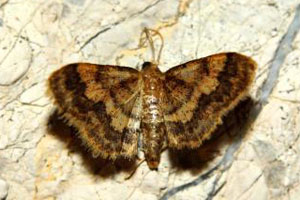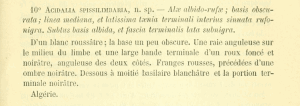

 +7Kontinente:EUAF
+7Kontinente:EUAF1. Lebendfotos
1.1. Falter
2. Diagnose
2.1. Erstbeschreibung
3. Weitere Informationen
3.1. Andere Kombinationen
- Acidalia spissilimbaria Mabille, 1888 [Originalkombination]
3.2. Faunistik
Die Art wurde nach einem Exemplar ohne nähere Angaben aus Algerien beschrieben, doch daran gibt es Zweifel - vielleicht war es doch Korsika, wo die Art auch noch später gefunden wurde. Hausmann (2004: 108) kannte außer dem Typusexemplar nur noch 8 weitere Individuen, alle aus Europa (Hautes-Alpes in Südfrankreich, Korsika, Rumänien und Bulgarien, alle aus mehr oder weniger montanen Gebieten. Pinzari et al. (2010: 202) meldeten dann das erste Exemplar aus (Zentral-)Italien: "1 ♂, Colle Marcone, 1121 m, 6.VIII.2001 (gen. praep. GEOM 126, M. Pinzari), M. Pinzari leg." S. 313 kommentierten sie: "New to Italy. According to Hausmann (2004) it is an exceedingly rare species of which only nine specimens are known. The presence of this species has so far been assessed for Corsica, Hautes Alpes (France), Romania and Bulgaria. The type locality is from Algeria, but apparently there are uncertainties on the actual place of origin of the holotype (cf. Hausmann, 2004)."
Seither gibt es wenige weitere Exemplare aus den Hautes-Alpes Südostfrankreichs und einen Erstnachweis aus Ungarn, über den Tóth (2023) berichtete: "The specimen was collected on 1 July in the town of Kőszeg, Vas County (Fig. 1), at the terrace of a resort. The terrace is situated 3 m above ground level. A 0.5 m wide and 1 m tall stand with shelves was covered with a white sheet which was illuminated with a 160 W HMLI bulb emitting mixed light. The equipment was placed at the terrace in order to protect the bulb from rain. The specimen came to the lit side of the sheet shortly after switching the light, around 21:15 (local time), immediately settled down with spread wings, like the general resting position of Idaea spp., and made no further movement." Die Fundstelle liegt nahe der Grenze zu Österreich, so dass auch dort - oder in der Südwest-Schweiz - mit dieser Art gerechnet werden müsste, was auch schon [Simon Hänni im Forumsbeitrag vom 1. Februar 2024] andeutete. Tóth (2023: 202) zeigt eine aktualisierte Gesamtverbreitungskarte der Art.
(Autor: Erwin Rennwald)
3.3. Literatur
- Dufay, C. (1983): Idaea spissilimbaria (Mabille), espèce nouvelle pour la France continentale et la Bulgarie. — Alexanor 13 (1): 13-15.
- Hausmann, H. (2004): The Geometroid Moths of Europe. Volume 2. Sterrhinae. - 600 S.; Stenstrup.
- Herbulot, C. (1968): Sur cinq Geometridae de Corse. — Alexanor, 5 (6) : 244.
- Erstbeschreibung: Laboulbéne, A. [Près.] (1888): Séance du 11 avril 1888. — Bulletin des séances et bulletin bibliographique de la Société entomologique de France 1888: LIV-LXIII.
- Pinzari, M., Pinzari, M.. & A. Zilli (2010): Deep lepidopterological exploration of Mt Cagno and surroundings (Central Italy), a restricted mountain massif and hotspot for butterfly and moth diversity (Lepidoptera). — Bollettino dell’Associazione Romana di Entomologia, 65 (1–4): 3–383. [zum PDF-Download auf researchgate.net]
- Tóth, B. (2023): Occurrence of Idaea spissilimbaria (Mabille, 1888) in Hungary (Lepidoptera: Geometridae). — Folia Entomologica Hungarica, 84 99–104. [PDF auf folia.nhmus.hu]










